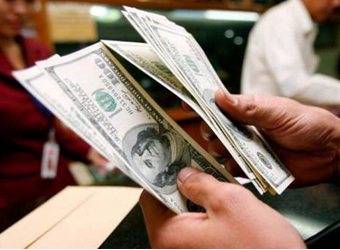Dollar prices touched its highest level in nearly eight months versus the yen on Monday, supported by expectations for continued monetary policy divergence between the Federal Reserve and the Bank of Japan.
The dollar rose to as high as 114.735 yen at one point, its highest since mid-March, its rise having gained added steam after breaching technical resistance at levels near 114.50 yen.
Later, the dollar pared some of its gains and was trading at 114.35 yen, up 0.3 percent on the day.
The contrasting outlooks for monetary policy in the United States and Japan contributed to the dollar’s firm tone against the yen, analysts said, with the Fed expected to stay on a path of gradual policy tightening while the BOJ is seen as in no hurry to exit its ultra-easy monetary policy.
BOJ Governor Haruhiko Kuroda said on Monday that it will proceed with powerful monetary easing under its yield curve control policy, although he also added that the central bank was closely watching the economic effects of a prolonged ultra-easy monetary policy.
Against this backdrop, one focus is whether the dollar can rise to levels beyond 115.00 yen, said Peter Dragicevich, G10 FX strategist for Nomura in Singapore.
“If we can manage to get through there, then I think that can open the door up to a move higher,” Dragicevich said.
The dollar index, which measures the greenback against a basket of six major currencies, last stood at 94.919, trading within sight of an Oct. 27 peak at 95.150, its highest point since July 20.
The dollar was resilient in the wake of underwhelming U.S. October jobs data released on Friday, which showed a slowdown in wage growth and a smaller-than-expected increase in nonfarm payrolls.
Although U.S. wage growth disappointed, analysts remain optimistic that wages will pick up, and there was little change in market expectations for the Fed to raise interest rates in December for a third time this year.
The jobs data, including the wage growth figures, were seen as being broadly in line with their recent trends, said Shinichiro Kadota, senior FX strategist for Barclays in Tokyo.
“It would be a concern if the weakness (in wage growth) persists in coming months, but the latest figures seem to be the result of a pullback after a swing seen in the previous month due to hurricane-related effects,” he said.
A Fed rate hike next month is already factored in by the market, which is also bracing for the possibility of one or two further rate increases in 2018, Kadota said.
The euro inched up 0.1 percent to $1.1616.
In the near-term, analysts said market participants will be watching to see whether there is more progress in U.S. tax reforms, while focus will also be on U.S. President Donald Trump’s visit to Asia.
Trump, charging Japan “has been winning” on bilateral trade in recent decades, said he would push for more reciprocal trade with Washington’s close U.S. ally – but in a “friendly” way.
Trump was speaking in Tokyo on the second day of a 12-day Asian trip expected to be dominated by North Korea and trade. Source: Reuters
Source: Reuters
